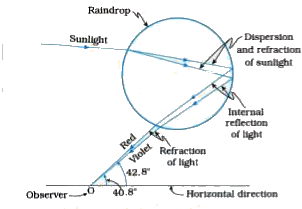A rainbow is an example of dispersion of sunlight. Justify this statement by explaining, with a neat labelled diagram, the formation of a rainbow in the sky. List two essential conditions for observing a rainbow.Solution in Gujrati
A rainbow is a natural spectrum appearing in the sky after a rain shower.
Rainbow is caused by dispersion of sunlight on refraction by tiny water droplets, present in the atmosphere.
It is always formed in the direction opposite to that of the Sun. So the rainbow is seen when the Sun is behind the observer.
Here, water droplets act like small prisms. They first refract and disperse the incident sunlight, then reflect it internally (not necessarily total internal reflection) and finally refract it again while it comes out of the raindrop.

This phenomenon is shown using schematic diagram in the figure, using only one water drop out of many water drops.
From the figure one can say that, the water drop causes internal reflection once and refraction twice of the incident ray of sunlight.
Due to dispersion of light and internal reflection, different colours reach the observer.s eye.
Conditions for observing a rainbow :
(a) after rainfall / at a water fountain.
(b) The Sun should be behind the observer.
Topper's Solved these Questions
- THE HUMAN EYE AND THE COLOURFUL WORLDBook:KUMAR PRAKASHANChapter:THE HUMAN EYE AND THE COLOURFUL WORLDExercise:TEXTUAL EXERCISE
Explore 13 Videos
- THE HUMAN EYE AND THE COLOURFUL WORLDBook:KUMAR PRAKASHANChapter:THE HUMAN EYE AND THE COLOURFUL WORLDExercise:ADDITIONAL QUESTIONS AND ANSWERS
Explore 9 Videos
- QUESTION PAPER-2 (MARCH,2020 - BOARD'S QUESTIONS PAPER)Book:KUMAR PRAKASHANChapter:QUESTION PAPER-2 (MARCH,2020 - BOARD'S QUESTIONS PAPER)Exercise:Section - D (Answer the following questions)
Explore 3 Videos
Similar Questions
The human eye can focus on objects at different distances by adjusting the focal length of the eye lens. This is due to…
View SolutionGive four points of difference between the following terms/ quantities :
Near- sightedness and Far- sightedness
View SolutionShyam a student has difficulty in reading the blackboard while sitting in the last row. What could be the defect the child is suffering from ? How can it be corrected ? Explain with help of appropriate diagram .
View SolutionAssertion : The rainbow is an example of the dispersion of sunlight by the water drops in the atmosphere. Reason : No reflection or refraction of light is involved in the formation of rainbow.
View SolutionWhen and where do we see a rainbow? How is a rainbow formed? Draw a labelled diagram to illustrate the formation of a rainbow.
View SolutionWhat is a rainbow? Draw a labelled diagram to show the formation of a rainbow.
View SolutionWith a neat labelled diagram, explain how a rainbow is formed.
View SolutionWhat is meant by dispersion of white light ? Describe the formation of rainbow in the sky with the help of a diagram.
View SolutionProve the following statement : A rainbow is the combined effect ( an exhibition ) of the refraction, dispersion , and total internal reflection of light ( taken together ) . OR With neat labelled diagram, explain how the formation of rainbow occurs.
View SolutionWith a neat labelled diagram explain Rainbow Formation.
View SolutionWhat is a rainbow ? Draw a labelled diagram to show the formation of rainbow. OR Describe the formation of rainbow in the sky with the help of a diagram.
View SolutionDraw a labelled diagram to explain the formation of a rainbow in the sky.
View SolutionWhat is a rainbow? Draw a labelled diagram to show the formation of a rainbow.
View SolutionGive an example of 'Natural Spectrum'. Explain the formation of a rainbow in sky with a neat labelled diagram.
View SolutionAssertion : The rainbow is an example of the dispersion of sunlight by the water drops in the atmosphere. Reason : No reflection or refraction of light is involved in the formation of rainbow.
View Solution

